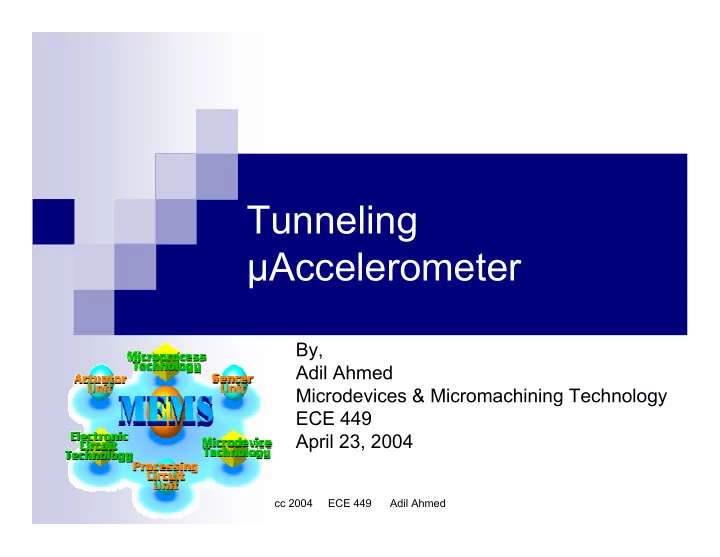

Tunneling µAccelerometer By, Adil Ahmed Microdevices & Micromachining Technology ECE 449 April 23, 2004 cc 2004 ECE 449 Adil Ahmed
Table of Contents Table of Contents � FUNDAMENTALS � Conventional Accelerometer � APPLICATIONS � µ Accelerometers � µ ACCELEROMETERS � Capacitive � Piezoelectric � Piezoresistive � Tunneling � STM � ADVANTAGE/DISADVANTAGE � FABRICATION PROCESS � Tunneling µ Accelerometer � CONCLUSION cc 2004 ECE 449 Adil Ahmed
Conventional Accelerometer: HOW IT WORKS HOW IT WORKS � Composed of the following: proof mass, spring and position detector � Proof mass will move from rest to a new position, determined by balance between its mass times acceleration and spring Fr � Acceleration α traversed distance � Force feedback approach: proof mass = constant � Feedback position information to control electrodes cc 2004 ECE 449 Adil Ahmed
µAccelerometers: APPLICATIONS APPLICATIONS Aerospace � � ↓ Cost � Shuttle Military � � Weapon detonation time Automotive Industry � � Air-bags deployment Suspended parallel beams that � make up an electrical capacitor, altering the amount of stored electrical charge when subjected to an acceleration Signal is then elaborated by a � microchip through an algorithm that evaluate if crash condition has been reached. Key Advantages: low cost, � extreme sensitiveness and reactivity related to the small dimensions, and the reliability due to the integration of the logic in the same device of the sensor. cc 2004 ECE 449 Adil Ahmed
µAccelerometers: CAPACITIVE CAPACITIVE � Capacitive � Proof mass as one plate of capacitor and base as other � Voltage changes when sensor accelerated � Applied acceleration cc 2004 ECE 449 Adil Ahmed
µAccelerometers: PIEZOELECTRIC PIEZOELECTRIC � Piezoelectric � Electrical charge develop due to force � W(mechanical input) ↔ W(electrical output) cc 2004 ECE 449 Adil Ahmed
µAccelerometers: PIEZORESISTIVE PIEZORESISTIVE � Piezoresistive � material's resistance value decreases when it is subjected to a compressive force and increases when a tensile force is applied. The piezoresistive element in the new accelerometer is formed by diffusing boron into silicon. 3-Axis Si Piezoresistive Accelerometer Acceleration applied along the X- or Y-axis causes the proof mass to incline (A), while acceleration along the Z-axis causes the mass to move in a downward direction (B) cc 2004 ECE 449 Adil Ahmed
µAccelerometers: TUNNELING TUNNELING � Tunneling � Metal-coated tip is brought to within a nanometer of spring- supported proof mass � Current will tunnel across separation if small bias voltage is applied � Applied acceleration causes a relative displacement of spring- supported proof mass, and change in tunneling current cc 2004 ECE 449 Adil Ahmed
ADVANTAGES/DISADVANTAGES ADVANTAGES/DISADVANTAGES µ ACCELEROMETER ACCELEROMETER ADVANTAGES DISADVANTAGES µ ADVANTAGES DISADVANTAGES Capacitive � Higher sensitivities � Complex fabrication than PR Piezoelectric � Generate own � Limited operation of signals, no need to be frequency range powered � AC-response sensors Piezoresistive � Not adversely � Temperature affected by sensitive (used in electromagnetic fields thermistors) Tunneling � Sub-nano level of � Potential for long- sensing displacement term drift (extreme sensitivities) � High resolution cc 2004 ECE 449 Adil Ahmed
TUNNELING µAccelerometer: STM STM Tunneling Accelerometer � � uses a general principle of operation that is commonly used for scanning tunneling microscopy (STM) STM � � a bias voltage is applied between a sharp metal tip and a conducting sample � quantum mechanical tunneling effects � tunneling current is exponentially dependent on the separation between the tip the sample Tunneling material = Au � � excellent stability � Prevents drift in the observed tunneling current over time � platinum-iridium alloys cc 2004 ECE 449 Adil Ahmed
TUNNELING µAccelerometer: FABRICATION PROCESS [I] FABRICATION PROCESS [I] Nitride 1. Deposit Nitride Layer Si Ti-Pt-Au 2. Tri-layer Metal Nitride Deposition Si SiO 2 3. Oxidation Nitride Ti-Pt-Au Si cc 2004 ECE 449 Adil Ahmed
TUNNELING µAccelerometer: FABRICATION PROCESS [II] FABRICATION PROCESS [II] SiO 2 4. Oxide Cavity Etch Nitride Ti-Pt-Au Si Si 5. CMP & Bond p ++ epi Si SiO 2 Nitride Ti-Pt-Au Si p ++ epi Si 6. Thin Down to Etch- SiO 2 Nitride stop Ti-Pt-Au cc 2004 ECE 449 Adil Ahmed Si
TUNNELING µAccelerometer: FABRICATION PROCESS [III] FABRICATION PROCESS [III] p ++ epi Si 7. Etch Tip Hole Through SiO 2 Nitride Epitaxial Layer Ti-Pt-Au Si p ++ epi Si SiO 2 8. Etch Tip Into Oxide Nitride Ti-Pt-Au Si Au p ++ epi Si 9. Metallize Tip & SiO 2 Nitride Contact Ti-Pt-Au Si cc 2004 ECE 449 Adil Ahmed
TUNNELING µAccelerometer: FABRICATION PROCESS [IV] FABRICATION PROCESS [IV] Au p ++ epi Si SiO 2 10. Define Cantilever Nitride Ti-Pt-Au Si Au p ++ epi Si 11. Oxide Etch & SiO 2 Nitride Release Ti-Pt-Au Si 12. Device is ready to be Packaged cc 2004 ECE 449 Adil Ahmed
CONCLUSION CONCLUSION MEMS Accelerometers � � Capacitive, Piezoelectric, Piezoresistive, Tunneling � Advantages/Disadvantages Tunneling µ Accelerometers � � Functionality � Testing the device Resources � � Micromachined Transducers Sourcebook � MEMS & Microsystems � IEEE Journal of Micromechanics & Microengineering � Fundamentals of Microfabrication � www.analog.com � www.stanford.edu cc 2004 ECE 449 Adil Ahmed
Recommend
More recommend